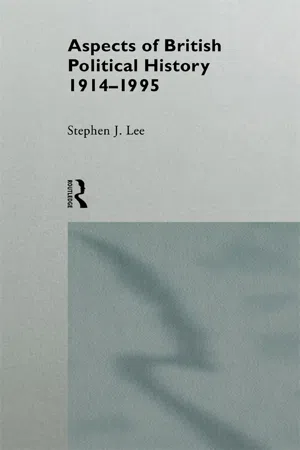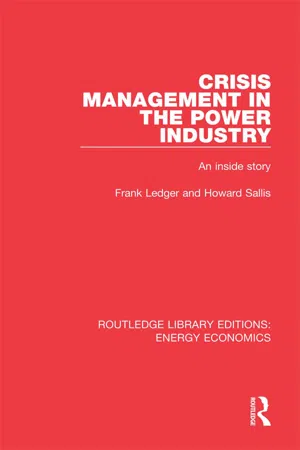History
Miners' Strike
The Miners' Strike refers to a major industrial action that took place in the UK from 1984 to 1985. It was a confrontation between the National Union of Mineworkers and the Conservative government over proposed pit closures and the future of the coal industry. The strike had significant social, economic, and political implications, and its legacy continues to be felt in British society.
Written by Perlego with AI-assistance
Related key terms
2 Key excerpts on "Miners' Strike"
- eBook - ePub
- Stephen J. Lee(Author)
- 2005(Publication Date)
- Routledge(Publisher)
In outline, British miners were in dispute with the mineowners who, in 1925, proposed to increase working hours and reduce wages to make the coal industry more competitive. Baldwin's Conservative government tried to prevent a conflict by providing a nine-month subsidy to maintain the existing level of wages; at the same time it appointed the Samuel Commission to propose a longer-term solution. In March 1926 the Commission recommended the ending of the subsidy, along with the introduction of temporary wage cuts until the owners could reorganise the mines more effectively. This was rejected by the owners, who announced a unilateral reduction of wages in April 1926. The miners resisted and appealed to the Trades Union Congress (TUC) for support. The TUC negotiated with the government to try to avert a general strike, which it was prepared to call, if necessary, to back the miners’ cause. When these negotiations broke down between 2 and 3 May, the TUC General Council called out transport and railway workers, printers, gas and electricity workers, and those employed in heavy industry. The remaining workers were to follow in due course. The government, in the meantime, had taken special precautions to combat the effects of the strike. These proved so effective that on 12 May the TUC decided to end the General Strike and accept the Samuel Memorandum. This was, however, rejected by the miners, who were left to fight alone until the end of the year, when the threat of starvation forced them back to work.This chapter deals with three main issues related to the events of 1925– 6. Why did Britain fall over the brink into a general strike in the first place? What was the range of views within the country concerning the strike and the strikers? And what was the significance of the General Strike in the short and longer terms?THE REASONS FOR THE GENERAL STRIKE
Four separate strands have to be disentangled before a full perspective can emerge on the reasons for the General Strike. One is the underlying state of the economy with the contraction of the basic industries and the consequent growth of unemployment and social hardship. The second is the specific impact of such conditions on the coal industry, which suffered more severely than any other. The third is the crisis which developed within the coal industry as the two sides—pit owners and miners— pursued aims which proved irreconcilable. The fourth, and most critical, is the policy pursued by the government to deal with this confrontation.The General Strike occurred during a period of painful economic adjustment. This was due partly to the shrinking of the staple industries such as coal, steel, textiles and heavy engineering which, before the First World War, had accounted for over 50 per cent of Britain's industrial output and 70 per cent of her exports. These continued after 1919 to take up most of Britain's resources and investment, even though they were becoming increasingly inefficient. Little was done to improve or modernise production techniques, in the way that was taking place in the United States and Germany, and the need for urgent readjustment was clouded by the illusion of security created by being on the winning side in the First World War. The problem was compounded by Britain's return to the gold standard in 1925, which inflated the price of exports by about 10 per cent, and by the growing pressure exerted within Britain by the growth of newer and more efficient industries like electricity and gas. As heavy industry became less and less competitive there was a strong tendency to blame lack of productivity on the level of wages, making industrial conflict more and more likely. - eBook - ePub
Crisis Management in the Power Industry
An Inside Story
- Frank Ledger, Howard Sallis(Authors)
- 2017(Publication Date)
- Routledge(Publisher)
Part IIThe miners’ strike 1984–5
This part tells the compelling story of the miners’ strike of 1984–5, doing so for the first time from the standpoint of the CEGB whose strength and resourcefulness were strained almost to their limits. Keeping the lights on was a statutory duty of the Board, not a weapon in a political battle, a distinction which the board strove to maintain at every stage of this bitter conflict. Yet nobody could doubt that failure to maintain supplies would have changed the course of history. The story concludes with the return of the miners to work with nothing to show for their struggles, with the CEGB returning to normal, and the industry and the nation beginning to count the cost.Note: In parts II and III the word ‘we’ is used frequently in the account of the 1984–5 miners’ strike. It can refer either to the CEGB senior management team of which one of the joint authors was a member or the broader CEGB organisation, depending on the context. In many cases it is not possible to name a single individual who carried out an action since most events involved a wide range of people at all levels and it is convenient to refer to the group as ‘we’.Passage contains an image
Chapter 8
Conflict in context
This chapter is not intended to deal with the immediate causes of the 1984–5 miners’ strike. Rather, it is concerned with the political, economic and industrial relations background which, indirectly rather than directly, helped to determine the attitudes of the NCB, CEGB, NUM and others who were either involved face-to-face or were drawn, in spite of themselves, into the conflict. The account starts towards the end of 1977 where it was left at the end of Chapter 7
Learn about this page
Index pages curate the most relevant extracts from our library of academic textbooks. They’ve been created using an in-house natural language model (NLM), each adding context and meaning to key research topics.

